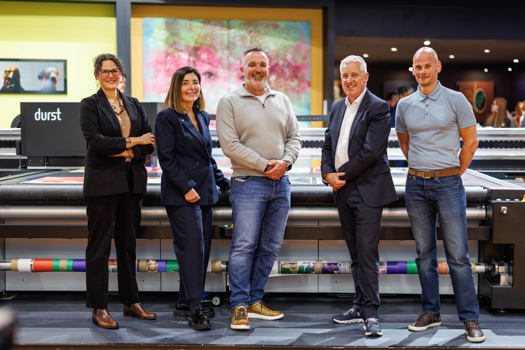Others are more forthright. And indeed colourful in their language.
“It (J)ust (D)oesn’t (F)*cking work!” says Julian Marsh, business consultant at the Harrier Group. “When JDF was announced a lifetime ago it was meant to be the solution to all our problems. A single, simple way of communicating in the print world. What we have ended up with is a discombobulated mess.”
Both are frustrated by the same thing, as are many others: that the holy grail of print workflow – an automated, standardised system that promised to manage a job all the way from estimate to the pallet on the back of a lorry – has, thus far, failed to deliver anything like that on a broad scale.
There are fingers of blame pointing in multiple directions for this failure, but there are others who find JDF to have useful capabilities, albeit on a limited level. And the manufacturers have far from given up on it.
So why has JDF not proved to be the be-all and end-all of printing kit communication? And is there a chance that it will one day deliver on its bold promises?
Finger pointing
In terms of who to blame for the current lack of omnipresence of JDF, there are quite a few fingers pointing in the direction of the manufacturers of press and finishing kit for failing to standardise their offerings.
“JDF is a wonderful concept but in reality everyone has their own little add-on,” says Alan Bunter, managing director of Remous Print. “All the kit I own is JDF compliant, but for the Komori press we need a certain bit of software that runs with JDF. Our Horizon finishing kit is JDF compliant but again we need another bit of software to run with JDF. For our guillotine, we would need a £5,000 card in it to talk to JDF. All of a sudden, JDF becomes prohibitively expensive.
“We are a £2m-turnover company with 20 staff. For us to implement JDF would cost £50,000, by the time we have bought all the extra interfaces and got someone – the MIS or the pre-press provider – to get them all to talk to each other. And that means hours of software engineers. It does not save us enough to make it work.”
Keith McMurtrie, managing director of Tharstern, agrees that adoption of JDF has been problematic, but not necessarily because of the standard itself.
“JDF set out to define a universal platform that would allow vendors to communicate with one another without having to write separate interfaces – to make use of the ‘write once use many’ principle. And that’s what it achieved,” he says. “We may not be seeing the level of automation and integration that we expected in the sector, but I don’t believe we can blame the JDF standard for that.
“The issue is the level of adoption from the vendors themselves. JDF has given them a base starting point to enable machines to communicate with one another, but each vendor has adopted it to varying degrees, and this makes collaborative working pretty difficult.”
Some manufacturers recognise the problem. Peter Dyson, Duplo International product development manager, admits that JDF often fails unless a printer has multiple bits of kit from the same supplier.
“To function correctly as a chain, all links in the chain must do their job automatically without user interaction. CIP4 [the organisation that manages the JDF standard] has examples of many successful case studies, but many of them are situations where the customer has an extensive number of elements from the same supplier, where any weak links can be patched and compensated for,” he explains.
Those weak links are essentially language problems. Bunter explains that he asked his MIS supplier to become JDF compliant and the supplier responded with a question: which JDF would you like us to be compliant with? The languages of JDF are multiple.
Andreas Aplien, product manager for Connex at Muller Martini – one of the manufacturers that was involved with JDF from the very beginning – concedes this is an issue, but explains that JDF is still preferable to any alternatives.
“JDF is a language with many different dialects. And not all the dialects are easy to understand or to integrate. But it is much easier to adopt to a new dialect than to learn a new language,” he explains.
Finishing last
It’s not just language that proved an issue, though: as John Davies, business strategy and marketing manager at Fujifilm explains, often printers simply do not have a full suite of JDF compliant kit at their disposal – and historically finishing has been where the issues lie.
“There were a couple of areas the vendors focused on, and that was a job starting in an MIS and that job moving into print production,” he says. “It seemed to be that with finishing kit, because it is often quite manual, the need for automation wasn’t as great as it was further upstream. A job could be set up in six or seven presses of a button. But over the past few years, new kit has come in that does use JDF.”
“‘Press to finishing’ was an issue due to a couple of points,” agrees Paul Chamberlain, product executive at Heidelberg. “Pre-setting on post-press equipment was limited [and] the mind-set of press operators for pre-setting was that it would make their job easier – we can’t get that in post-press because of the lack of pre-setting data.”
Aplien counters that the hold-up for post-press was overcome as early as 2012 for his company – all Muller Martini machines were JDF-ready from then – but, put simply, many printers run much older machines. He admits that some of the company’s competitors still lag behind, but he says the failure of MIS providers to get on board is just as much of an issue.
“There aren’t many MIS vendors that can write a proper JDF for the complete production process. They are all good in pre-press and press integration... but when it comes to post-press it becomes complicated,” he argues.
So, as mentioned earlier, the fingers of blame go in multiple directions. Press manufacturers, MIS vendors, finishing kit suppliers – they all come in for a slating when JDF is mentioned. So is it simply the case that no-one really needs it to work enough for it to be successful? Bunter thinks that might be the case.
“No one has the balls to take it on and run with it. The appetite and the trust are not there to make it work,” he says.
Davies takes a more diplomatic stance - he simply thinks JDF was expected to do too much, too soon, and as more and more legacy kit gets replaced, JDF will become more common and will improve its functionality.
“In the early days, the promise was just a bit too big and widespread – it was meant to be addressing so many things at the same time,” he explains. “It is a slow burner; it has gradually got better over time.”
If we give it more time, he says, that original dream of standardised automation might become a reality.
But some fear it won’t be given that time to grow. Heidelberg’s Push To Stop and HP’s PrintOS products, launched at Drupa, will, they say, mark the start of a tide of innovation that will see off JDF for good. Both products claim to revolutionise print production and bring automation benefits.
McMurtrie is doubtful either will directly challenge JDF, though.
“HP’s PrintOS also uses an API and requires those that want to collaborate in this environment to write a specific interface for it. While this is an exciting international movement – and I’m sure will be adopted by many – whether this could ultimately be a replacement for JDF, I doubt very much,” he says.
“Heidelberg’s Push to Stop technology is a concept and not a standard architecture like JDF. It’s taking advantage of capability that’s been on Heidelberg presses for some time and adding some improvements to the user experience in commissioning an operation.”
And McMurtrie and Aplien believe XJDF, also announced at Drupa 2016, will take JDF to the next level to compete with any challengers. It “removes duplicity and complexity” from the original JDF, according to McMurtrie.
“The new XJDF will be easier to integrate and the development will use all the knowledge we gained over the last 16 years,” adds Aplien.
But McMurtrie does acknowledge what Bunter referred to earlier: it doesn’t matter how good the system is, it won’t work unless everyone wants to make it a success.
“As much as everyone accepts that it makes technical sense, the challenge is for vendors in these difficult and challenging commercial times to commit more resource into supporting what is effectively a new format,” says McMurtrie.
Will they do that? Several printers – and a couple of the manufacturers – chuckled at the suggestion.
“They want you to buy as much kit from them as possible, so why would they make it easier to buy someone else’s?” asked the managing director of one SME printer, who wished to remain anonymous. “ The answer is, they won’t.”









